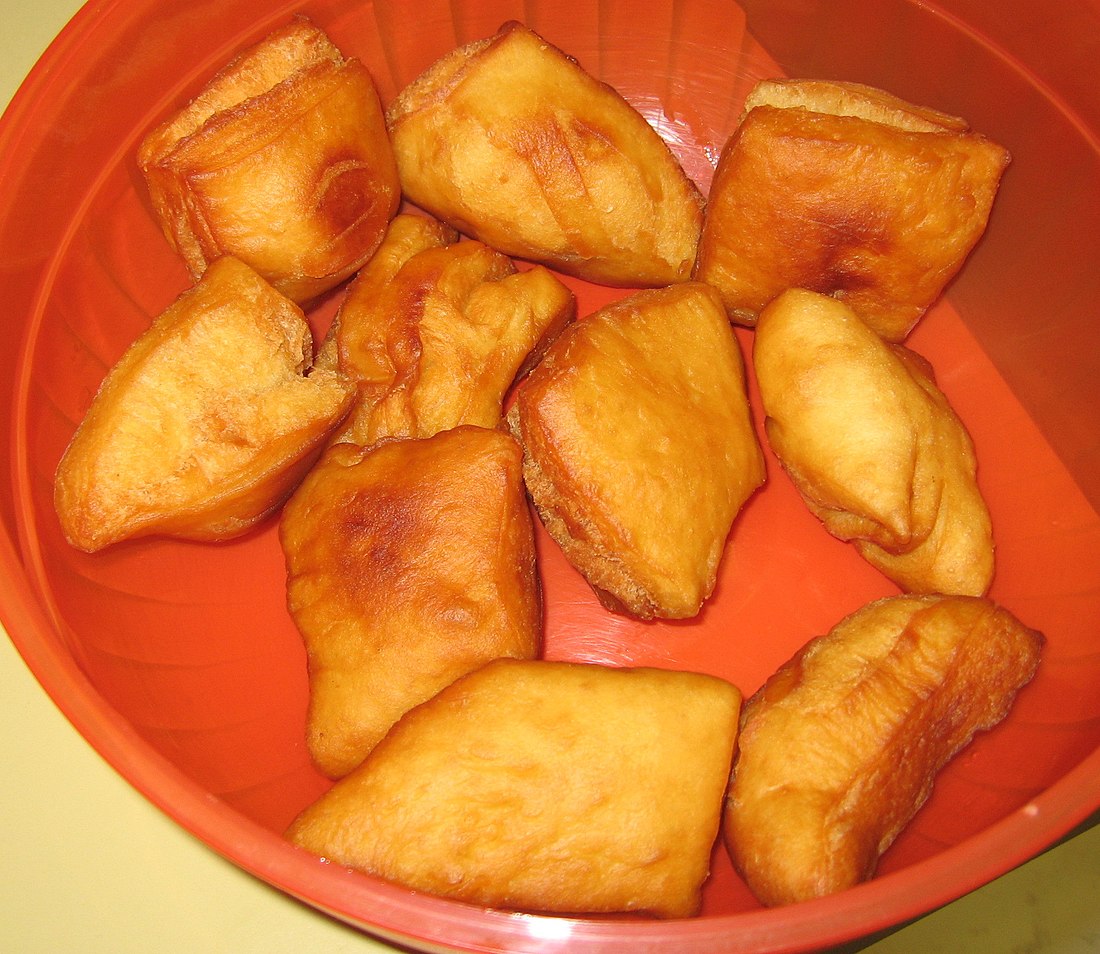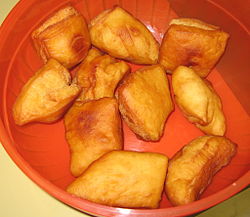Top Qs
Timeline
Chat
Perspective
Boortsog
Traditional fried dough of Central Asian and Middle Eastern cuisines From Wikipedia, the free encyclopedia
Remove ads
Boortsog, boorsoq, baursak, baursaq, bauyrsaq, borsok[a] or boorsok is a fried dough food found in the cuisines of Central Asia, Idel-Ural, Mongolia and the Middle East.[1] They are shaped into triangles or sometimes spheres.[2] The dough consists of flour, yeast, milk, eggs, butter, salt, sugar, and margarine.[3] Tajik boortsog are often decorated with a criss-cross pattern by pressing the bottom of a small strainer on the dough before it is fried. It has been adopted by Cossack cuisine as "bursak".
This article needs additional citations for verification. (February 2011) |
Boortsog is often eaten as a dessert, with syrup, jam, or honey. They may be thought of as cookies or biscuits; since they are fried, they are sometimes compared to doughnuts. Mongolians and Turkic peoples sometimes dip boortsog in tea. In Central Asia, boorsok is often eaten alongside chorba.[4]
Mekitsa (Serbian Cyrillic: бухтички, pronounced [uʃtɪpt͡sɪ]) are doughnut-like fried dough balls popular in Bosnia and Herzegovina, Croatia, Bulgaria, Serbia, especially in Vojvodina, Srem district and Slovenia where they are known as "miške".
Remove ads
Preparation
Dough for boortsog ranges in ingredients from a simple dough to a sweeter, crispier dough. For example, a typical Kyrgyz recipe calls for one part butter, seven parts salt water, and six parts milk, along with yeast and flour, while more complex recipes add eggs and sugar. Also, the dough could be made with kaymak.
Boortsog are made by cutting the flattened dough into pieces. While not usually done in Central Asia, these pieces may be bent and knotted into various shapes before being deep-fried. This is especially common among Mongolians. The dough is deep-fried golden brown. Mutton fat is traditionally used by Mongolians to give the boortsog extra flavor, but vegetable oil may be substituted.[5][6][7][8]
Remove ads
World records
The biggest (179 kg) boorsok was cooked on April 20, 2014, in Ufa, Russia. 1,006 eggs, 25 kg of sugar, 70 kg of flour, 50 kg of Bashkir honey were used for its preparation.[9] A Guinness record was made in Almaty, on September 7, 2014, during the celebration of Mother's Day, when 856 kilograms of baursaks were cooked in one place in one day. The celebration was held in the form of a culinary battle between teams of mothers-in-law and daughters-in-law. Seven teams participated in the competition.[10]
Remove ads
Gallery
See also
Bibliography
- Mayhew, Bradley; John Noble (2007). Central Asia: Kazakhstan, Tajikistan, Uzbekistan, Kyrgyzstan, Turkmenistan. Multi Country Guide. Lonely Planet. ISBN 978-1-74104-614-4. Retrieved 12 November 2009.
- Schreiber, Dagmar (2008). Kasachstan: Auf Nomadenwegen zwischen Kaspischen Meer und Altaj (in German) (3rd ed.). Trescher Verlag. ISBN 978-3-89794-137-3. Retrieved 12 November 2009.
- Waters, Bella (2007). Kazakhstan in Pictures. Visual Geography (2nd ed.). Twenty-First Century Books. ISBN 978-0-8225-6588-8. Retrieved 12 November 2009.
Remove ads
Notes
- /ˈbɔːrtsɒɡ/; Mongolian: боорцог [ˈpɔːr̥t͡sɞk]; Bashkir: бауырһаҡ, romanized: bawırhaq; Kazakh: бауырсақ, romanized: bauyrsaq [bɑwərˈsɑq]; Kyrgyz: боорсок, romanized: boorsok [bɔːrˈsɔq]; Turkmen: пишме, romanized: pişme; Uzbek: boʻgʻirsoq [bɒʁɨrˈsɒq]; Turkish: kabarcık, pişi, bişi, tuzlu lokma, halka
References
External links
Wikiwand - on
Seamless Wikipedia browsing. On steroids.
Remove ads




